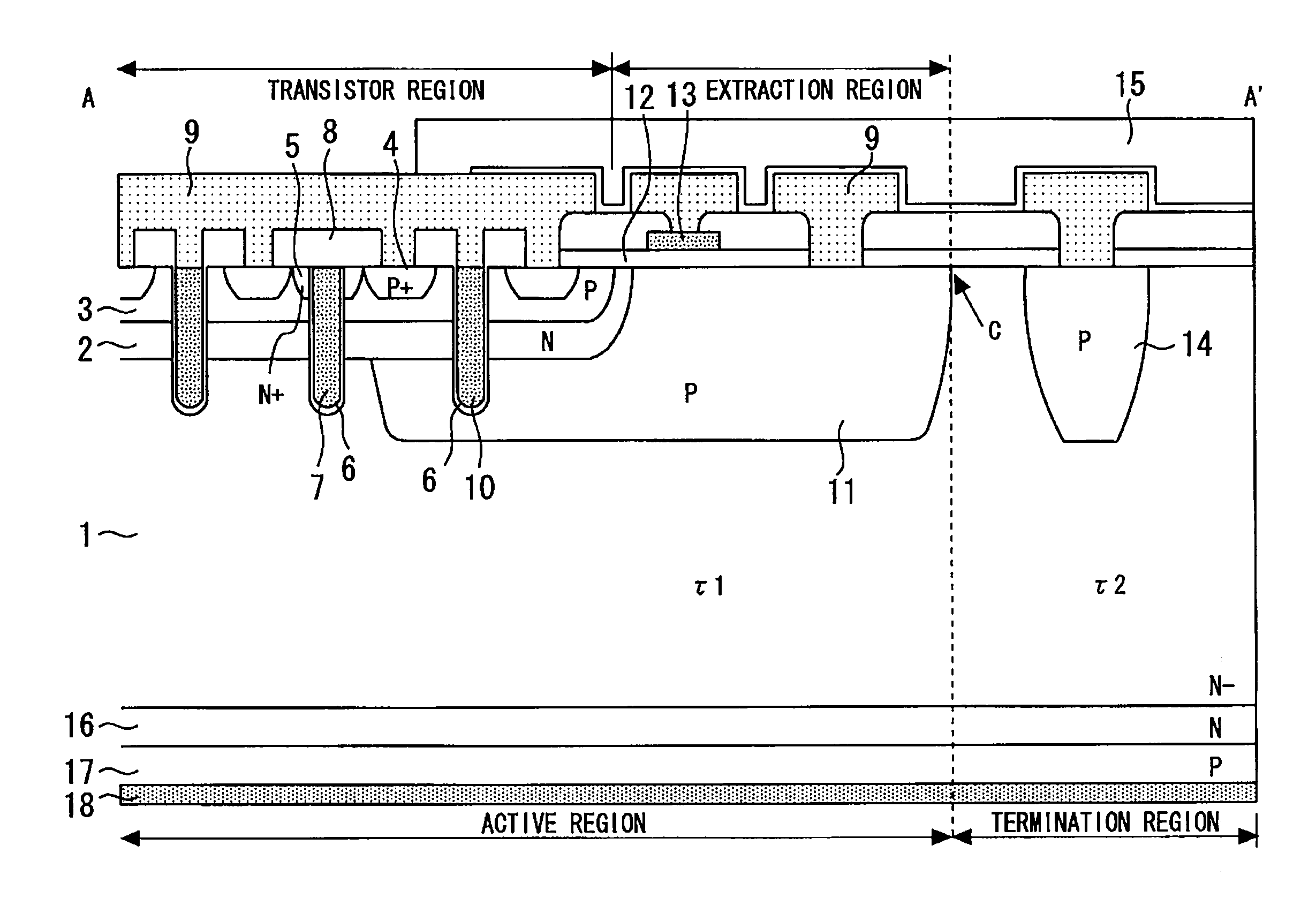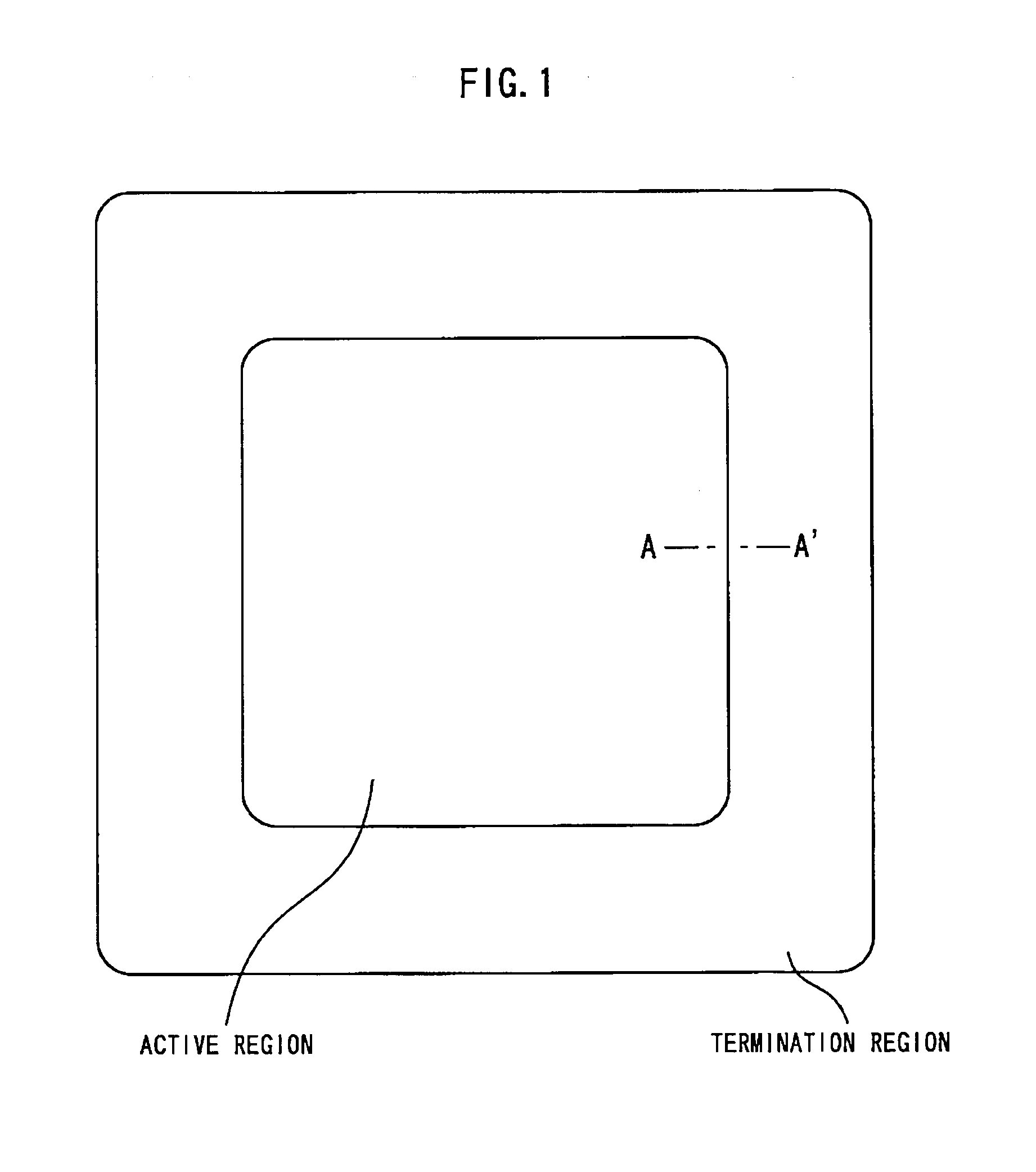Semiconductor device
a technology of semiconductors and devices, applied in the direction of semiconductor devices, basic electric elements, electrical appliances, etc., can solve problems such as resistance and voltage rise, and achieve the effects of reducing resistance, improving current breaking capability, and lowering voltag
- Summary
- Abstract
- Description
- Claims
- Application Information
AI Technical Summary
Benefits of technology
Problems solved by technology
Method used
Image
Examples
first embodiment
[0027]FIG. 1 is a top view showing a semiconductor device according to the first embodiment of the present invention. The semiconductor device is a power device of high withstand voltage (600 V or higher) having an IGBT. A termination region is placed around an active region. If a voltage is applied between a collector and an emitter when the IGBT is turned off, a depletion layer extends laterally in the termination region. Therefore, by forming the termination region, withstand voltage can be maintained. In addition, when the IGBT is ON, although a principal current flows in the active region, no principal current flows in the termination region.
[0028]FIG. 2 is a sectional view taken along the line A-A′ in FIG. 1. The active region includes a transistor region having a plurality of trench-gate-type IGBT structure, and an extraction region placed between the transistor region and the termination region.
[0029]In the transistor region, an N-type charge accumulation layer 2 is formed o...
second embodiment
[0046]FIG. 12 is a sectional view showing a semiconductor device according to the second embodiment of the present invention. In the transistor region and the extraction region, an N-type buffer layer 16 is formed under an N−-type drift layer 1, and a P-type collector layer 17 is formed thereunder. In the termination region, an N-type buffer layer 19 is formed under the N−-type drift layer 1. A collector electrode 18 is directly connected to the P-type collector layer 17 and the N-type buffer layer 19. In other words, the N-type buffer layer 19 in the termination region is directly contacted (short-circuited) to the collector electrode 18.
[0047]Next, the effect of the second embodiment will be described comparing to a comparative example. In the comparative example, the P-type collector layer 17 is formed also in the termination region, and the N-type buffer layer 19 is not directly contacted to the collector electrode 18.
[0048]FIG. 13 is a diagram showing an evaluative circuit when...
third embodiment
[0052]FIG. 15 is a sectional view showing a semiconductor device according to the third embodiment of the present invention. In the transistor region and the extraction region, an N-type buffer layer 16 is formed under the N−-type drift layer 1. In the termination region, an N+-type buffer layer 20 is formed under the N−-type drift layer 1. A P-type collector layer 17 is formed under the N-type buffer layer 16 and the N+-type buffer layer 20. A collector electrode 18 is connected to the P-type collector layer 17. The impurity concentration of the N+-type buffer layer 20 is higher than the impurity concentration of the N-type buffer layer 16.
[0053]In the third embodiment, an N+-type buffer layer 20 having a high impurity concentration is formed in the termination region. Thereby, since hole implantation from the P-type collector layer 17 is suppressed in the termination region during the turn-off operation of the IGBT, depletion from the P-type layer 11 to the collector side is accel...
PUM
 Login to View More
Login to View More Abstract
Description
Claims
Application Information
 Login to View More
Login to View More - R&D
- Intellectual Property
- Life Sciences
- Materials
- Tech Scout
- Unparalleled Data Quality
- Higher Quality Content
- 60% Fewer Hallucinations
Browse by: Latest US Patents, China's latest patents, Technical Efficacy Thesaurus, Application Domain, Technology Topic, Popular Technical Reports.
© 2025 PatSnap. All rights reserved.Legal|Privacy policy|Modern Slavery Act Transparency Statement|Sitemap|About US| Contact US: help@patsnap.com



